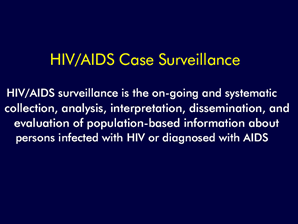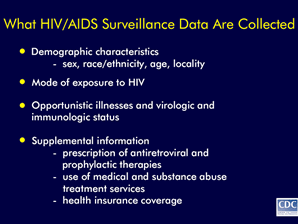|
|
|
|
|
|
||
|
Divisions of HIV/AIDS Prevention |
|||||||
| Slide Sets | Home | Index | Search | Site Map | Subscribe | Contact Us |
HIV/AIDS Surveillance Methods
L266 slide series
(through 2000)
Download complete set (11 slides) in PDF format (Adobe Acrobat v5.0 or higher) - (508,122 bytes)
Download complete set (11 slides) in PPT format (PowerPoint v4.0 or higher) - (992,768 bytes)
NOTE: To download files "right click" mouse on the link for the file to download, and select "Save Link" or "Save Target".
Adobe Acrobat (TM) Reader v5.0 or higher needs to be installed on your computer
in order to be able to read the slides in Adobe PDF (Portable Document Format).
Download the Adobe Acrobat (TM) Reader
 |
 |
| Slide #1 HIV/AIDS Case Surveillance |
Slide #2 How HIV/AIDS Surveillance Data Are Collected |
| Zoom/Download Slide #1 | Zoom/Download Slide #2 |
 |
 |
| Slide #3 Core HIV/AIDS Surveillance Information Flow |
Slide #4 What HIV/AIDS Surveillance Data Are Collected |
| Zoom/Download Slide #3 | Zoom/Download Slide #4 |
 |
 |
| Slide #5 Core Surveillance: Reporting the Spectrum of HIV/AIDS Morbidity and Mortality |
Slide #6 Confidentiality of HIV/AIDS Surveillance Data |
| Zoom/Download Slide #5 | Zoom/Download Slide #6 |
 |
 |
| Slide #7 Evaluation of Surveillance Systems |
Slide #8 Representativeness of HIV/AIDS Surveillance Data |
| Zoom/Download Slide #7 | Zoom/Download Slide #8 |
 |
 |
| Slide #9 Limitations of HIV/AIDS Surveillance Data |
Slide #10 Uses of HIV/AIDS Surveillance Data |
| Zoom/Download Slide #9 | Zoom/Download Slide #10 |
 |
|
| Slide #11 Dissemination of HIV/AIDS Surveillance Data |
|
| Zoom/Download Slide #11 |
